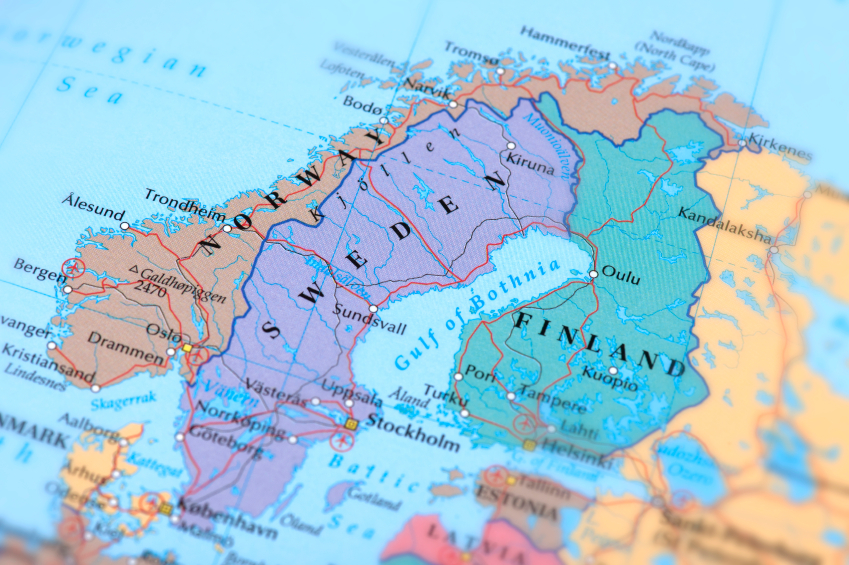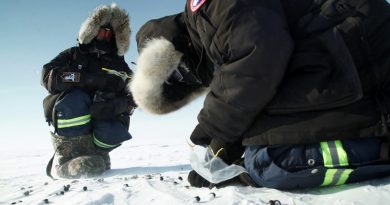U.S aircraft flew Norwegian airspace on mission outside Russia’s nuclear sub bases

Norway’s reassurance policy towards Russia has for the most followed a practice that allied intelligence missions to airspace outside the Kola Peninsula should not take off, land, or fly over Norwegian airspace.
On Wednesday, a U.S. Air Force plane was indeed inside Norwegian airspace, both before and after the flight aimed to monitor Russia’s military forces from above the eastern Barents Sea.
The security crisis in Europe has rippling effects on the North.
After joint training with a pair of Norwegian F-35 fighter jets over Troms region inside the Arctic Circle on Wednesday, the American RC-135W aircraft continued to international airspace over the Barents Sea and flew a well-known surveillance route just north of Russia’s Kola Peninsula.
These are the home waters of the powerful Northern Fleet’s nuclear-powered submarines and surface warships.
The Barents Observer tracked the aircraft via FlightRadar24 after newspaper Nordlys earlier in the day published a photo taken by a local showing the RC-135 wing-by-wing with the F-35s over Ringvassøya.
At 12.45 pm (Norwegian time) the U.S. plane was north of Murmansk on return.
Flying a northwest route, the plane suddenly turned south from international airspace and entered Norwegian airspace just north of Honningsvåg. The plane continued south over Sørøya, Kvænangen and further towards the Ofoten region at 32,000 feet.
It flew along the Norwegian mainland towards Trøndelag and the southern regions of Norway before crossing the North Sea en route back to the military air base Mildenhall in Great Britain.
Spokesperson with the Norwegian Air Force, Lieutenant colonel Eivind Byre, confirms to the Barents Observer that there was joint training in the air earlier in the day.
“It was training with American and Norwegian aircraft over Norwegian airspace today. What the Americans did after the training, in international airspace, is something we can’t answer for,” Lt. Col. Byre said.
He declined to comment more in detail on the KC-135’s return flight over mainland Norway, as seen on FlightRadar24.
The plane landed at the airbase in Mildenhall north of London shortly before 4 pm local time.
The Barents Observer has asked for comments from the Ministry of Defense and will update this article as soon as the official reply is made available.
Norway was one of the 12 founding members of NATO. But, being a small nation with direct land border with the Soviet Union, the country has all since 1949 tried to balance its security relations with the much larger neighbor to the east on deterrence and reassurance.
The reassurance includes a ban on nuclear weapons on Norwegian soil, no foreign military bases and strict limitations on other NATO countries’ possibilities to exercise in the eastern part of Finnmark region. Foreign fighter jets or bombers should not fly in a defined security zone near the Russian border, limited to east of 28 degrees.
Also, as part of the reassurance policy, allied intelligence missions north of the Kola Peninsula are advised not to happen from Norwegian airports.
Case-by-case permission
Such surveillance flights in transit over Norwegian airspace to or from missions near Russian airspace in the north need special clearance from the Ministry of Defense in Oslo, in every single case.
Therefore, such flights by the United Kingdom or the United States starts from airbases in the UK and the flight up north have for the most been outside Norwegian airspace.
All airspace outside 12 nautical miles from a coastal state’s baseline is international airspace where all nations are allowed to fly.
Senior Defense Analyst Per Erik Solli with the Norwegian Institute of International Affairs explains that there is currently an opening on a case-by-case basis to allow allied non-combat aircraft on a Barents Sea surveillance mission to transit through Norwegian airspace.
“The Norwegian policy and rules and practice regarding Allied military aircraft missions in the High North is not written in stone. The regime has been adapted and adjusted several times since the 1950s, the last time in 2019,” Solli said to the Barents Observer.
Russian military activity
Last week, Russia tested its nuclear triad, including a Sineva ballistic missile launched from a Delta-IV submarine in the Barents Sea and Yars mobile ground missile launched from the Plesetsk cosmodrome in the Arkhangelsk region.
For this week, November 3 to 5, two larger areas in the Barents Sea and the White Sea are closed off with NOTAM warnings. It is not said what kind of military activity will take place, more than a mention of “rocket shooting” for the area west of Novaya Zemlya.
Military alert level raised
On November 1, the Government in Oslo decided to increase the readiness of the Norwegian Armed Forces.
‘We are confronting the most serious security situation we have seen in decades. There are no indications that Russia intends to expand its war to other countries, but rising tensions mean that we are more exposed to threats, espionage and foreign influence operations. This makes it necessary for all NATO countries, including Norway, to be more vigilant,’ said Prime Minister Jonas Gahr Støre.
Speaking at the Nordic Council meeting in Helsinki on Wednesday, Norway’s Defense Minister Bjørn Arild Gram said Russia’s brutal war on Ukraine causes long-lasting changes in the security situation for the Nordic region.
The minister underlined the importance of the Nordic defense cooperation.
“Finnish and Swedish NATO membership will be the start of a new era in Nordic security policies,” Gram said.
From Moscow, foreign ministry spokesperson Maria Zakharova noted Norway’s strengthened national security, calling it “Oslo’s conscious choice of the destructive policy of escalating tensions in the Euro-Arctic region.”
The spokesperson added:
“It is impossible not to notice that over the past few years Oslo has been consistently pursuing a policy of abandoning the policy of ‘self-restraints‘ and is stepping up military preparations in the northern regions adjacent to the Russian-Norwegian border.”
Related stories from around the North:
Canada: Canada’s North spared from national military staff shortages, CBC News
Faroe Islands: Faroe Islands’ Arctic strategy focuses on security, climate & cooperation, Eye on the Arctic
Finland: No return to pre-war reality when it comes to Arctic cooperation, says Finnish rep, Eye on the Arctic
Greenland: Greenland, Iceland sign cooperation agreement in Reykjavik, Eye on the Arctic
Iceland: Arctic Circle—The outside world keeps walking in, Blog by Marc Lanteigne
Norway: Hybrid threat researcher detained in Tromsø on suspicion of being Russian agent, Thomson Reuters
Russia: Newly deployed nuke-bombers at Kola is certainly a signalling, expert says, The Independent Barents Observer
United States: China, Russia among global priorities, including in Arctic, in U.S. security strategy, Eye on the Arctic



